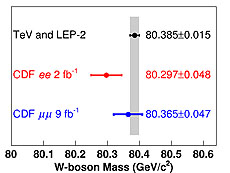An indirect measurement of
the W mass using muon pairs
 |
| Comparisons of the world's average of direct measurements of the mass of the W boson (TeV and LEP-2, in black), with the recent CDF indirect measurements extracted from the forward-backward asymmetry of Z bosons (in red and blue). |
The W boson is one of the particles that mediates electroweak interactions. Scientists have put forth great effort to determine its mass, and a recent column related CDF's documentation of the single most precise direct measurement. This column summarizes an indirect determination of the W mass. This indirect method, using electrons, has been used by both CDF and DZero.
In the Standard Model of particle physics, the masses of the Z and W bosons are related to another parameter of the theory called the electroweak mixing angle sin2θW. This angle is a parameter in the unification of the weak and electromagnetic interactions, known as the electroweak interaction of the Standard
Model.
Since the Z boson decays into a muon or electron and its antiparticle, all of which can be tracked in the detector, scientists can determine its mass very precisely.
A precise measurement of the mass of the W boson is harder because the W boson decays into a muon or electron and its partner neutrino, which does not leave a trace in the detector and therefore goes undetected. The mass of the W can be obtained from the mass of Z and sin2θW.
For this CDF measurement, scientists used the full Tevatron Run II sample of 277,000 Z boson decays into muon-antimuon pairs. In this experiment, a quark from the proton interacts with an antiquark from the antiproton, producing a Z particle, which then decays into a pair of oppositely charged leptons (muons or electrons). The process is called Drell-Yan pair production.
Because of the presence of the weak interaction in the Standard Model, on average the negatively charged muon from the decay of the Z boson has a slight preference for being emitted in the direction of the proton over that of the antiproton. A measurement of the asymmetry between the number of Z events with negatively charged muons emitted in the direction of the proton (forward) and events with negatively charged muons emitted in the direction of the antiproton (backward) can be related to the value of sin2θW.
The above figure shows a comparison of the world average of the combined direct measurements of the W mass from CDF, DZero and LEP-2 (labeled TeV and LEP-2). The previous indirect measurement is labeled CDF ee 2 fb-1 (in red). This measurement is labeled CDF μμ 9 fb-1 (in blue). We measure the mass of the W to be 80.365 ± 0.047 GeV/c2, and this is in good agreement with both the direct and earlier indirect measurements. Stay tuned as CDF physicists are now analyzing Z decays into electron-positron pairs in the full Tevatron data set of 9 fb-1.
Learn more
—edited by Andy Beretvas
 |
| These physicists were responsible for this analysis.
From left: Arie Bodek, Jiyeon Han and Willis Sakumoto,
all from the University of Rochester |
|